catalogue
2, Create an instance of a class
1. Constructor 1 (public File(String pathname))
2. Constructor 2 (public File(String parent,String child))
3. Constructor 3 (public File(File parent,String chile))
①. There are different path separators in different systems
III. common methods of File class
public String getAbsolutePath()
2. Create a new file and write its contents
2. The following two methods apply to file directories:
public boolean renameTo(File dest)
public boolean createNewFile(): file creation
public boolean mkddir(): creation of file directory
public boolean mkdirs(): creation of file directory
1, Concept
⚪ java.io.File class: abstract representation of file and file directory path, which is platform independent
⚪ File can create, delete and rename files and directories, but file cannot access the file content itself. If you want to access the file content itself, you need to use input \ output stream
⚪ To represent a real File or directory in a Java program, there must be a File object, but a File object in a Java program may not have a real File or directory
⚪ The File object can be passed as a parameter to the stream constructor
2, Create an instance of a class
(1) Common constructors

1. Constructor 1 (public File(String pathname))
@Test
public void test1(){
File file1 = new File("hello.txt");
File file2 = new File("E:\\BaiduNetdiskDownload\\javasenior\\day08\\src\\java4\\he.txt");
System.out.println(file1);
System.out.println(file2);
}2. Constructor 2 (public File(String parent,String child))
File file3 = new File("E:\\BaiduNetdiskDownload","javasenior");3. Constructor 3 (public File(File parent,String chile))
File file4 = new File(file3,"hi.txt");
(2) Path
1. Relative path
Compared to the path specified under a path
@Test
public void test1(){
File file = new File("hello.txt");
}2. Absolute path
The path to the file or file directory that contains the drive letter
File file2 = new File("E:\\BaiduNetdiskDownload\\javasenior\\day08\\src\\java4\\he.txt")3. Path separator
Each level of directories in the path is separated by a path separator
①. There are different path separators in different systems
- Windows and DOS systems are represented by "\" by default
- UNIX and URL s are represented by "/"
②. matters needing attention
Java programs support cross platform operation, so the path separator should be used with caution
To solve the above hidden dangers, the File class provides a constant:
public static final String separator
Provide separators dynamically according to the operating system

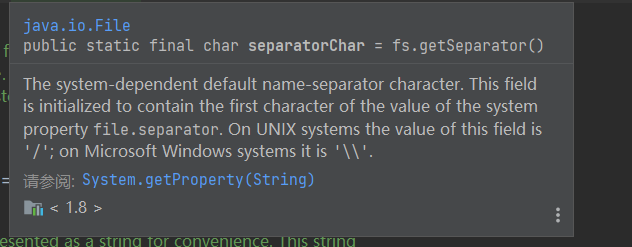
III. common methods of File class

(1) Get
public String getAbsolutePath()
Get absolute path
public String getPath()
Get path
public String getName()
Get name
public String getParent()
Get upper level file directory path
public long length()
Get the file length (i.e. the number of bytes), but cannot get the length of the directory
public long lastModefied()
Gets the last modification time (in milliseconds)
1. Use of the above methods:
@Test
public void test2(){
File file1 = new File("hello.txt");
File file2 = new File("E: \\IO\\hi.txt");
System.out.println(file1.getAbsoluteFile());
System.out.println(file1.getPath());
System.out.println(file1.getName());
System.out.println(file1.getParent());
System.out.println(file1.length());
System.out.println(file1.lastModified());
System.out.println();
System.out.println(file2.getAbsoluteFile());
System.out.println(file2.getPath());
System.out.println(file2.getName());
System.out.println(file2.getParent());
System.out.println(file2.length());
System.out.println(file2.lastModified());
}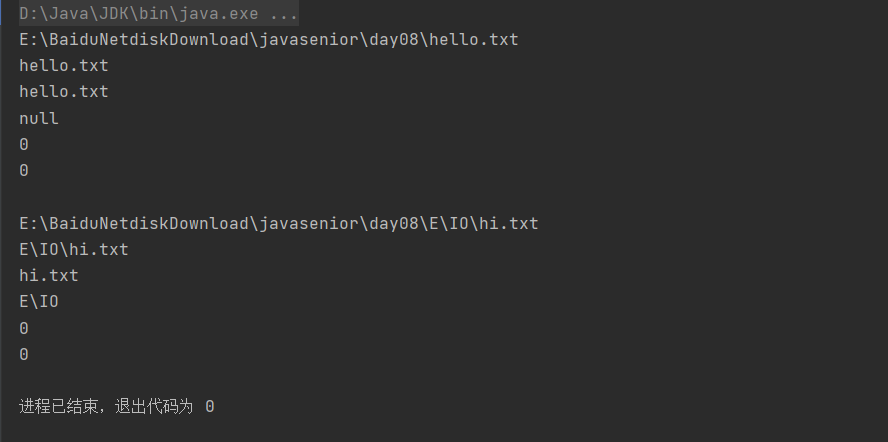
2. Create a new file and write its contents

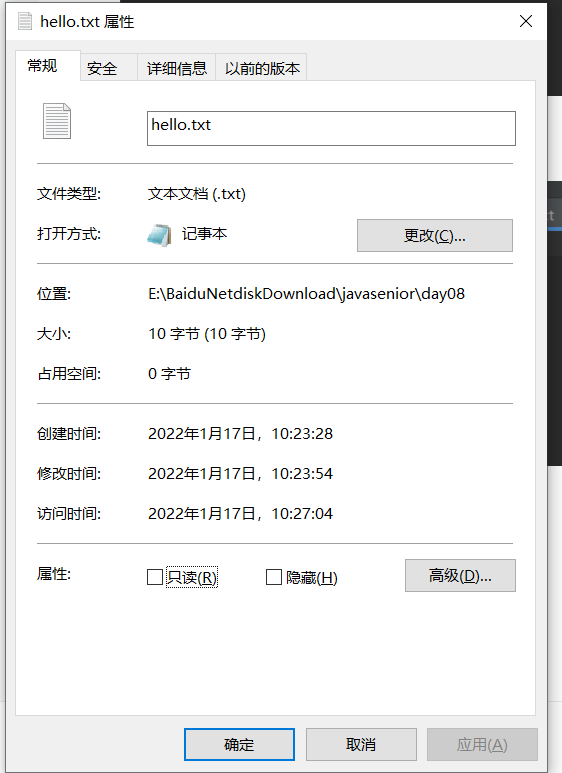
3. Run the above code again
@Test
public void test2(){
File file1 = new File("hello.txt");
File file2 = new File("E: \\IO\\hi.txt");
System.out.println(file1.getAbsoluteFile());
System.out.println(file1.getPath());
System.out.println(file1.getName());
System.out.println(file1.getParent());
System.out.println(file1.length());
System.out.println(new Date(file1.lastModified()));
System.out.println();
System.out.println(file2.getAbsoluteFile());
System.out.println(file2.getPath());
System.out.println(file2.getName());
System.out.println(file2.getParent());
System.out.println(file2.length());
System.out.println(file2.lastModified());
}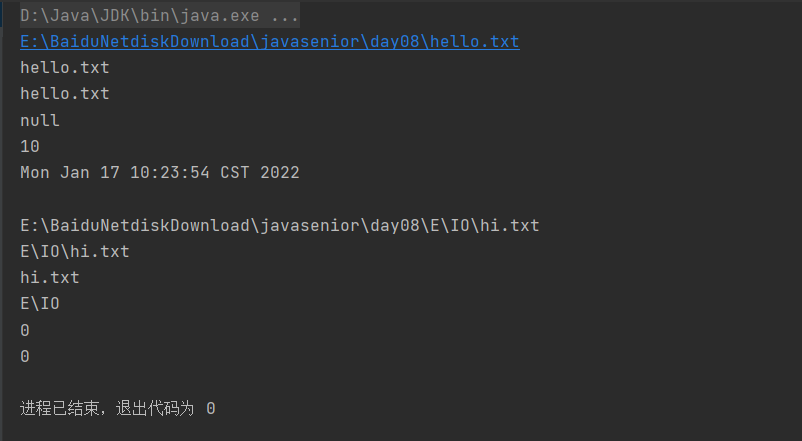
2. The following two methods apply to file directories:
① public String[] list()
Gets the name array of all files or file directories in the specified directory
@Test
public void test3(){
File file = new File("E:\\BaiduNetdiskDownload\\javasenior");
String[] list = file.list();
for(String s : list){
System.out.println(s);
}
}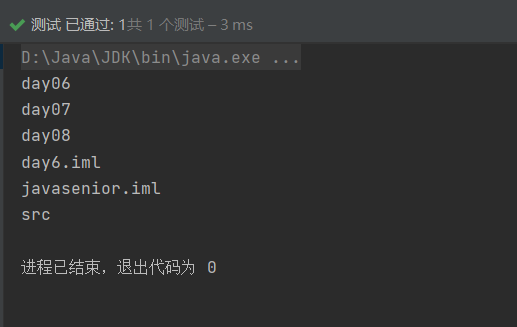
② public File[] listFiles()
Gets the File array of all files or File directories in the specified directory
File[] files = file.listFiles();
for(File f : files){
System.out.println(f);
}
(2) Rename
public boolean renameTo(File dest)
Rename the file to the specified file path
In file1 Rename to (File2) as an example:
To ensure that the return is true, file1 must exist in the hard disk, and file2 must not exist in the hard disk
@Test
public void test4(){
File file1 = new File("hello.txt");
File file2 = new File("E:\\IO\\hi.txt");
boolean renameTo = file1.renameTo(file2);
System.out.println(renameTo);
}(2) Judge
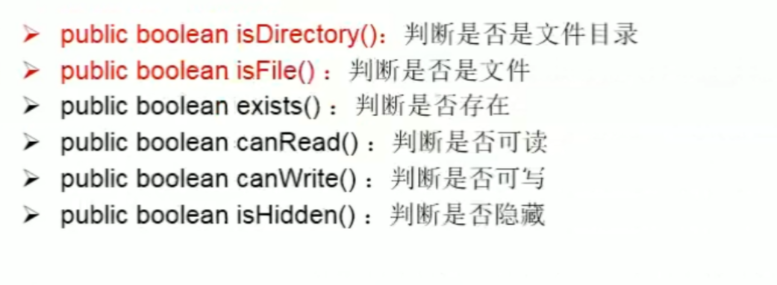
public boolean isDirectory()
Determine whether it is a file directory
public boolean isFile()
Determine whether it is a file
public boolean exists()
Judge whether it exists
public boolean canRead()
Judge whether it is readable
public boolean canWrite()
Determine whether it is writable
public boolean isHidden()
Determine whether to hide
@Test
public void test5(){
File file1 = new File("hello.txt");
System.out.println(file1.isFile());
System.out.println(file1.isDirectory());
System.out.println(file1.exists());
System.out.println(file1.canRead());
System.out.println(file1.canWrite());
System.out.println(file1.isHidden());
}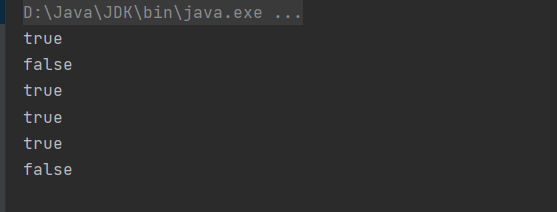
(3) Create
public boolean createNewFile(): file creation
@Test
public void test6() throws IOException {
File file1 = new File("hi.txt");
if(!file1.exists()){
file1.createNewFile();
System.out.println("Created successfully!");
}else {//File exists
file1.delete();
System.out.println("Delete succeeded!");
}
}public boolean mkddir(): creation of file directory
File file1 = new File("E:\\IO\\io1");
boolean mkdir = file1.mkdir();
if(mkdir){
System.out.println("Created successfully!");
}public boolean mkdirs(): creation of file directory
File file2 = new File("E:\\IO\\io2");
boolean mkdirs = file2.mkdirs();
if(mkdirs){
System.out.println("Created successfully!");
}difference:
@Test
public void test7(){
File file1 = new File("E:\\IO\\io1\\io3");
boolean mkdir = file1.mkdir();
if(mkdir){
System.out.println("Created successfully 1!");
}
File file2 = new File("E:\\IO\\io1\\io4");
boolean mkdirs = file2.mkdirs();
if(mkdirs){
System.out.println("Successfully created 2!");
}
} 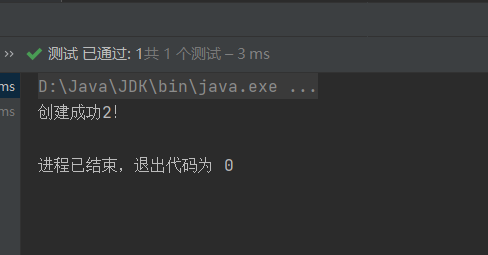
When io1 does not exist, it can be created successfully by using mkdirs()
(IV) deletion

public boolean delete()
